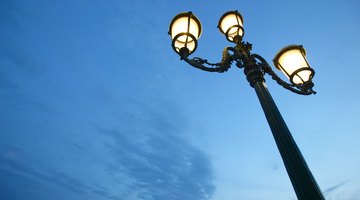How to Install Outside Coach Lights
Coach lights look similar to the historic lamps used on stage coaches of old. The modern version is a wall-mounted exterior light used for security and convenience lighting on houses and garages. Install coach lights as part of a new construction or add them to existing walls to enhance the home’s value and livability.

Things You Will Need
- Coach light fixture
- 3-wire electrical cable
- Wire cutter
- Fish tape
- Fixture box
- Wire nuts
-
Install a fixture box at the desired location for the coach light. In new construction, the fixture boxes are nailed to the studs before the exterior wall sheeting and siding is installed. Cut a hole in the siding, from the exterior, for remodel projects. Install special fixture boxes that clip into place.
-
String a wire to fixture box. In new construction, the wires are strung when the walls are unfinished on the inside. The wire will attach to the electric source of an outlet, other light fixture or the house’s breaker box. In remodeling projects, the wires are pulled through the wall using fish tape. Fish tape, a semi-rigid metal strip, is pushed into the wall opening toward another outlet or light fixture. Once the other fixture is reached, the wire is attached to the fish tape and pulled back to the new coach light fixture.
-
Cut the wires to a length, leaving about 4 inches in the fixture box. Attach the wires of the coach light to the same colored wires of the house wire, using wire nuts. Wire nuts are plastic and copper connectors that hold wires together. First twist the wires together and then screw the wire nuts on the wires.
-
Fasten the coach light fixture to the fixture box. Most fixtures utilize two screws through the fixture into the threaded holes in the box. Tighten the screws into place. Apply caulking around the light fixture to prevent water from entering the fixture box.
Tip
As with most electrical projects, adding an outdoor coach light is easier during initial construction. Fishing wires in for the light fixture and the light switch can be difficult in walls that have been finished on both sides and contain insulation in the wall cavity.
References
Tips
- As with most electrical projects, adding an outdoor coach light is easier during initial construction. Fishing wires in for the light fixture and the light switch can be difficult in walls that have been finished on both sides and contain insulation in the wall cavity.
Writer Bio
Keith Allen, a 1979 graduate of Valley City State College, has worked at a variety of jobs including computer operator, medical clinic manager, radio talk show host and potato sorter. For over five years he has worked as a newspaper reporter and historic researcher. His works have appeared in regional newspapers in North Dakota and in "North Dakota Horizons" and "Cowboys and Indians" magazines.
Photo Credits
- Hemera Technologies/AbleStock.com/Getty Images
- Hemera Technologies/AbleStock.com/Getty Images
More Articles



